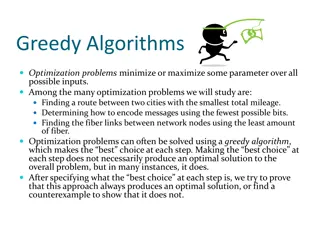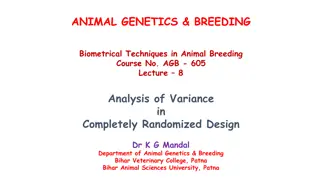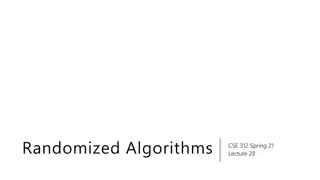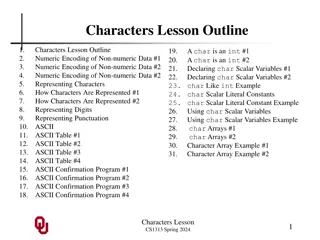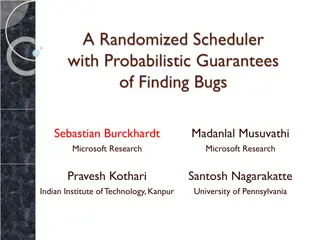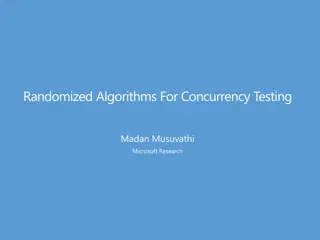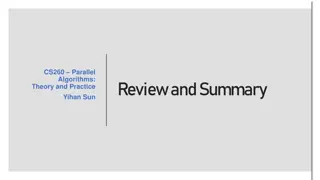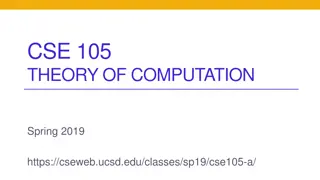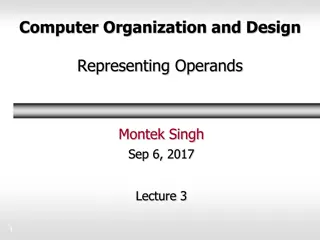Advanced Encoding Techniques in Randomized Algorithms
Explore innovative approaches in randomized algorithms through techniques such as perfect memory, efficient card guessing strategies, and polynomial encoding methods over finite fields. Learn how to optimize memory usage and enhance predictive capabilities in algorithmic processes.
- Randomized algorithms
- Encoding techniques
- Memory optimization
- Algorithmic strategies
- Polynomial encoding
Download Presentation

Please find below an Image/Link to download the presentation.
The content on the website is provided AS IS for your information and personal use only. It may not be sold, licensed, or shared on other websites without obtaining consent from the author. Download presentation by click this link. If you encounter any issues during the download, it is possible that the publisher has removed the file from their server.
E N D
Presentation Transcript
Randomized Algorithms Lecturer: Moni Naor Lecture 8
Recap and Today Recap Today Guess the cards Local Lemma
Guess the card Guessing the next card: deck of n cards shuffled and cards are drawn one by one You try to guess the next card, for n rounds No memory: expected number of correct guesses: 1 1 ?+ ? 1+ 1 1 ?+ 1 Perfect memory: expected number of correct guesses: ?? Idea: remember the first s (in terms of face value) cards and ignore the rest What if there are s bits of memory? Can get ?? Is this the best possible? No! Can do much better
First Idea: Encoding the last cards Can know for certain the last card using log n bits: keep track of the sum. Need log n bits. Can generalize to the k last cards using O(k log n) bits: for instance, the polynomial from the set comparison protocol Track the value of the polynomial at k points Starting with the value of the points of the set S={1, 2, n} Can use this to get ?? for ? = ?/????
Idea: Two Methods are Compatible! Of the s bits: use s/2 for the first method and s/2 for the second. The last card with face value in {1, ..., s/2} expected when there are 2n/s cards left. So for ? ? the two useful periods do not overlap! We get min{??? ,??} For s = ? this is almost as much as for s=n Optimal split?
Encoding the Last k Cards over a finite field of size at least n+k The algorithm: 1. Compute the polynomial on the set ? ={1, ,n} ??? = (? ?) ? ? 2. Pick k many x s: n+1, n+2, n+k, evaluate ??? at these points and store each value separately. 3. As card y goes by: divide the value at point x = n+i by (n+i-y). 4. When k-1 many cards left: reconstruct the k-1 degree polynomial using the k points, and recover remaining values.
Encoding the Last k Cards Note: we use the setting of the multi-set comparison The polynomial ??? should be defined over a finite field of size is larger than the universe from which the elements of ? are chosen+|?|. Size n+k in our setting say a prime Q > |U|.
Better Idea: Low Memory Card Guessing by Following Subsets Claim: There is a method using s bits of memory that obtains ? ???? ????, ? in expectation In other words: with log2? bits of memory you get the close to the maximum benefit. Encoding: you can get away with just the simple idea of summing the cards.
The General Method Idea: follow the cards that appeared in various subsets of [n]. For each such subset use two accumulators: Sum of the values of the cards seen so far Number of the cards from the set seen so far Memory: O(log n) If there is such a subset where all but one card appeared Can detect it The card is a reasonable guess What if there are two such subsets?
Subset Construction Consider the subsets [1-1][1-2],[1-4],[1-8],[1-16],[1-32], ..., [1-n] The Algorithm! If there is a range where a single card is missing then this card is the current guess. Property: In this construction there cannot be competing good cards to guess: For all k and k : If card i is the missing one from [1-k], then there cannot be a different one missing from [1-k ]
Analysis Call a subset [1,w] useful if the last card from it that appears in the permutation is not the last card in the next range/subset [1,2w]. If a range is useful: then it necessarily contributes a good guess. And the only one to which this guess is attributed So the number of good guesses is simply the number of useful ranges. Number of bits for a set of size w: log w bits for the counter log w bits for the sum log ? ? = log2? 2 ?=1
Analysis Call a subset [1,w] useful if the last card in it is not the last card in the next range [1,2w]. The probability that a range [1,w] is useful is the probability that in the next range [1,2w] the last card does not come from [1,w]. This is ! 1 w 2w The expected number of useful ranges is log?.
Improvements Take more ranges: ratio between two successive range is (1 + ?). log1+?? such sets Probability of a set being useful is The expected number of useful sets is ? 1+?log1+?? = This goes to ln n as ? goes to zero. (1 + ?) w 1 w ? 1+? ? 1 ln (1+?)ln n 1+? Can also add other subsets and keep track of them Analysis will be harder. Deduce missing cards by adding a few equations together.
The Low Memory Case What can we do if s is small, say ? log2? In this case we can get ? Treat the domain as if it is of size 2? Ignore all other cards! Now s = log2(2?) and we can run the previous guesser on domain of size 2?
Different Analysis Appraoch For each position (time) 1 ? ? , what are the chances that there is a reasonable guess at this point in time? Reasonable guess: of a card that has not appeared yet A subset/range with a single missing card. Want most time periods to have a reasonable guess and get the result of the perfect memory case
Probabilistic Construction Suppose that we construct random subsets with various probabilities: For each 1 ? log? construct a subset ??by picking each element independently with probability 2?/?. At step t what is the chance that there is a reasonable candidate? To yield a reasonable guess t steps from the end, subset ??should intersect the unseen set of cards in with size 1. Appearing intime slots n-t+1,...,n ??
??random set prob 2? ??cards unseen so far Analysis ? To yield a reasonable guess at step t, subset ??should intersect suffix ??with size 1. Pr[|?? ??| = 1] = ? 2? t ? 1 ~1 1 2? ~1 ? ? ? Number of possible intersection Prob. of a particular element being in ?? Prob remaining elements not chosen to ?? Prob. of reasonable guess - constant Set log? ? j log? ? t n-t
Amplification Can use more sets for each j. Each set chosen independently prob goes down with the number of subsets. Can get for any ? to (1 ?) ln? Using O(log(1/ ?)) subsets Altogether O(log(1/ ?)log2n) bits of memory
New: Working Against a Static Adversary Adversary chooses the sequence of cards ahead of time and independent of the guesses it sees Knows the algorithm Any randomness that should be accessed again and again is charged to the memory As a first step: assume the guesser has access to the randomness for free The [1][1-2] construction does not work: simply put 1 at the end. The probabilistic construction works but the issue is the size of the representation
Pair-Wise Independence Representation Idea: use pair-wise independence to represent the set choice. Recall: subset ??constructed by picking each element independently with probability 2?/?. Let : ? [?] be pair-wise independent function. Example: h(x) = ax+b over a field The set defined by h: all i s.t. 1 ? 2? The representation cost: O(log n) bits Does it work? Assume n is a power of 2
Analysis of Pair-Wise Independence Representation To yield a reasonable guess at step t, subset ??should intersect suffix ??with size 1. Pr[|?? ??| = 1] = ? 2? ? 1 1 2? Using full independence Used: ? ? Number of possible intersection Prob. of a particular element being in ?? Prob remaining elements not chosen to ?? Now only pair-wise: Union Bound 1 ? 2? Pr ?? ?? = 0 ? ~1 ~1 2 Set log? Pr[|?? ??| = 1] ? 2? 1 ? 2? 2t ? 1 j log? ? -1 ? ?
An Adaptive Adversary What happens in the adversarial case, when the memory is wide open for the adversary to see Each subset on its own works fine, but to work together you need that the one subset finishes before the second one starts being effective Weaker adversarial model: adaptive card choice. Can choose the sequence based on the guesses made Boaz Menuhin: lower bound of (log?)
Proof by Encoding: A general method for analyzing probabilistic events A method to prove success of an algorithm by showing that failure allows us to compress the random bits used. Prob. of compressing and chopping off w bits is ? ? Example (not directly related): the birthday paradox Suppose that you can expect a collision in less than k random elements ?1,?2, ,??from a domain of size n If ??=??then can encode ??using i. Instead of log n bits need log k + log k bits. Not likely to happen before ? For i LZ style ? For j
Proof by Encoding Inverting a random function is hard Given black-box access to a random function ?: 0,1? 0,1?and A challenge y 0,1? goal is to find x s.t f(x) =y Claim: number of queries needed is close to 2? Proof: Homework
Proof by Encoding Given black-box access to a random function ?: 0,1? 0,1?and A challenge y 0,1? goal is to find x s.t f(x) =y Claim: number of queries needed is close to 2? Proof: Suppose can invert y within T steps with probability p Will use to compress ? to fewer than ?2?bits needed for random function Fix the inverter s bit as well as y Sequence of queries and answers ?1,?1, ?2,?2, ,(??,??) With probability at least p: one of the ?? s is y Savings: ? log? Only log T Bit to record Which one Only these recorded
Tight bound on the expected number of guesses Claim: Suppose that s log2?,and ? > 0. Then any algorithm using s bits of memory can get on expectation (over the cards) at most ? ? ? ?? ? + ? ? ?? ? Set ?=?1 ? correct guesses. For =ln/ ? this is 2 ? ? ? 1 (? ? + 1) Proof idea: Use the guessing algorithm to encode an ordered set of size ? with fewer than log(? ??!) bits. Save around the order of the number of correct guesses in last ? steps using only s bits of memory. R. V.
The Encoding Memory state of guesser: s bits On this part may guess ?? ??= ??? ? [n]\? ? n-t These represent the savings t The correct guesses |T|=t and t=?1 ? Simulate the guesser till the end and see when it gives correct guesses These can be used to help describe T
The Encoding t=?1 ? Let ? ? be an ordered set of size t Consider the state of the guesser t steps from the end. The set of cards so far was ? \T According to a random permutation No need to waste bits on it Encode T using the guesser The s bits of the state Encoding where the correct guesses occurred within ? Ordered set of size t- for the rest of the elements of ? To make the process random t ? ? 1 (? ? + + 1)
The Encoding The Encoding of ? Memory state of guesser: s bits s bits Random order Set of locations of correct guesses [n]\? ? ? Values at incorrect locations n-t t The correct guesses Simulate the guesser till the end and see when it gives correct guesses These can be used to help describe T
The contradiction We count the number of the ordered sets ? in two different ways: 1. ? ? 1 (? ? + 1) all the possible options for ordered ? ? ? ? 1 (? ? + + 1) 2s- upper bound on the possible options for ordered ? according the encoding. 2. The s bits of the state of guesser
The s bits of the state of guesser The Contradiction The two ways to count: ? ? ? 1 (? ? + + 1) 2s ? ? 1 (? ? + 1) ? 2s (n t + ) n t + 1 (? ? + 1) (n t) t 2s Taking ln: ? = ?1 ? ln( ? ?) ln ?=1 ? ? ? From the part before ? ln ? Overall guesses at most: ln n+ 1 ? ? ln ? To choose best ?: ?/ln? Both summands are ? ( ?)
Conclusion Theorem: There is a guesser using s bits of memory that obtains? in expectation and Any guesser using s bits of memory can get at most O(??? ????, ? ) correct cards in expectation ???? ????, ? correct cards
Mirror Games Two players, `first and `second , game: A virtual deck with 2n cards Each round: alternating players should pick a card (value in 1..2n) that has not appeared so far If any player repeats a card that has appeared: loses the game. If all cards are picked: draw With perfect memory a draw is reached Claim: Second player has a strategy that requires very little memory
Mirror Games Claim (Sumagha Garg and Jon Schneider): first player does not have a deterministic strategy that uses sublinear space and guarantees a draw. What about probabilistic strategies? Garg and Schneider and Feige: Suppose first player has access to a secret matching Can use techniques like the subset encoding we saw to figure out numbers that have appeared so far Whenever the Second player guesses the `Old Maid - the unmatched value
Discussion and Open Problems Refine getting to (1-o(1))ln n. Do we need to go to log(1/ ?)log2??
Homework What about high concentration? Relationship with card counting in Blackjack??
Homework: Guess the card Half of the cards are red half black Cards turned one by one At any point can stop and guess that the next card is red What is the probability of success of best algorithm? Note: look at exercise 2.32 in the book The Secretary problem These are not the same problems
The Lovasz Local Lemma Statement Application Constructive Algorithmic
The Union Bound ? = ?1,...?? For ??, the dependencies on ? \ {??} may be arbitrary Theorem: If there are 0 ??< 1 s.t. for all ??: Pr[??] ?? ?=1 then the probability that no event ??happens is positive. If all the ??= ? then need that ? ? < 1 Example: a CNF formula with ? clauses where each clause has more than log ? literals is necessarily satisfiable Event ??: clause i is not satisfied. Pr ?? < 1/? a collection of random events. ???< 1 For a uniformly random assignment
The (Lovasz) Local Lemma Question: what happens with k-wise independent events? ? = ?1,...?? For ??, let (??) be a minimal set of events that ?? depends on ??is independent of all events in ? \ (??) information on events not in (??) {??} does not affect the probability of event ??happening. Theorem: If there are 0 ? < 1 and d s.t. for all ??: Pr[??] ? | (??)| ? ? ? ? < 1 then the probability that no event ??happens is positive. a collection of random events. Not symmetric Simultaneously: ????[ ? [?] ??] > 0
Applying The Local Lemma for k-CNF Theorem: If there are 0 ? < 1 and d s.t. for all ??: Pr[??] ? (??) d pde <1 then the probability that no event ??happens is positive. No dependency on the number of variables n or number of clauses m Theorem: Every k-CNF formula in which each variable appears in less than 2?/?? clauses is satisfiable. Proof: for a uniformly random assignment to the variables, Prob[??is not satisfied] 2 ? Each clause depends on at most 2? Event ??: Clause ?? not satisfied If two clauses do not share a variable, their satisfiability is independent ?? ? = 2?/? clauses. Taking p= 2 ?and d= 2?/? we get that the probability the formula is satisfiable is positive. How to find the satisfying assignment?



